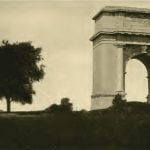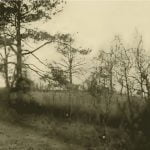
Scenes At Valley Forge Vicksburg
In the nature of the case field fortifications are temporary erections, earthworks thrown up for an immediate emergency; but, occasionally some bright deed or some momentous consequence gives these defenses a fame more enduring than walls of stone planned with deliberation and executed with leisured care.
Who has not heard of Valley Forge and the heroic winter of 1777-1778 which Washington spent there with his meagerly clad men? Valley Forge is now a public reservation about twelve miles north of Philadelphia, on the Schuylkill River. Excursion trains run out from that city to the park, so it is easy of access. The grounds cover hundreds of acres, but the principal points are plainly marked and may be quickly reached.
One of the most interesting souvenirs of Washington’s immortal encampment at Valley Forge is the little stone house, which the great commander used as his headquarters. An unpretentious, substantial structure of the typical style of building of the days in which it was constructed, it is in excellent preservation, strong and sturdy as on the day of its erection. The building contains numerous Washington relics and curios collected by the State authorities or presented to the park by men and women of various parts of the nation.
One of the most conspicuous objects of the reservation is the Memorial Arch erected by the United States government to the memory of the men and officers who shared the privations of that terrible winter at this spot. It is of Roman character and stands on a commanding eminence in the central part of the grounds. Near at hand is planned the Washington Memorial Chapel, which the Future may complete, or leave unbuilt, as it sees fit.

Fort Washington, a small redoubt or earth, is not far from the Arch and has been carefully preserved against the encroachments of time. The lines of the earthworks may also be made out.
A historic site is Yorktown, Virginia, the sleepy little village on the peninsula between the James and York rivers Cornwallis surrendered to Washington and the French allies in 1781, thus making sure of American Independence, and where the Army of the Potomac encamped under McClellan in 1862, throwing up massive earthworks. The traces of both Cornwallis’ and McClellan’s encampments are easily to be made out today.
The American and French forces marched from Williamsburg, September 28, 1781, driving in the British outposts at Yorktown as they approached and taking possession of the abandoned outworks. Forming a semicircular hne about two miles from the British entrenchments they completely invested the enemy, the York River enclosing his forces to the northeast. October 17, Cornwallis offered to discuss terms of surrender.
The beginning of the year 1863 – to make a jump from the Revolution to the Civil War – saw the turning of the tide for the United States, and it was in this year that the decisive battles of Vicksburg, Gettysburg and Chattanooga were fought. The battlegrounds of each of these engagements have been created national parks and are maintained in such a fashion that the visitor may follow the movements of the troops in those great clashes.

After the capture of the posts north of Vicksburg, on the Mississippi, and the opening of the mouth of the river by Farragut’s taking of New Orleans in 1862, Vicksburg was the only remaining defense of the Confederacy on the Mississippi, and the sole remaining link between the Confederacy’s east and west portions. The principal works of the city were on a commanding eminence, giving a clear sweep of the river and the surrounding country, which was swampy and almost impassable. They were competently manned, capably officered and well supplied.
The place, altogether, was deemed almost impregnable. To follow out all of the steps by which its reduction was brought about is not the province of this chapter. The United States troops under the comparatively unknown commander, U. S. Grant, began to operate at the end of January 1863, and on July 4 concluded their task in the unconditional surrender of the main fortification of the Confederates. The surrender of Vicksburg came one day after the conclusion of the battle of Gettysburg, which occupied the first three days of July. The reservation of the Vicksburg National Park contains 1,255.07 acres and was acquired pursuant to an Act of Congress approved February 21, 1899.
The grounds of the Gettysburg National Park, Adams County, Pennsylvania, comprise 2,054 acres and their acquisition was commenced in 1873. The scenes of the principal movements of the battle have been marked with suitable monuments. The battle of Gettysburg proved conclusively that the South could not invade the North. It was the last gallant attempt of a completely invested country to strike a fatal blow before the stranglehold of its enemy should bring the end.

The largest of the national military parks is Chickamauga and Chattanooga National Park, which comprises 5,688 acres in the State of Georgia, in addition to nearly 150 acres in the State of Tennessee, the park being situated on the line between the States. In Tennessee is located Lookout Mountain. The acquisition of this reservation began under the provisions of an Act of Congress approved August 19, 1890.
On the outskirts of Petersburg, Virginia, the remains of Forts Haskell and Steadman, the scene of the “Crater” episode, and part of the defenses of the capital of the Confederacy which fell before Grant in 1865, have been preserved as a private enterprise. For a small consideration the “Crater” and the earthworks will be shown to the visitor. The Federal forces opposed to Fort Steadman at the suggestion of a miner from Chambersburg, Pa., it is said constructed a long tunnel from their lines to beneath the Confederate stronghold. An enormous quantity of powder was here, and when it was set off a body of soldiers was to charge through the breach and take the Confederate positions.
The powder was exploded and the plan was successful in so far that it blew several hundred men into eternity, but when the attacking column reached the cavity in the ground its men became confused, giving the Confederates time to reform and to pour in a terrible fire upon the Union men concentrated in the broken ground below. The result was terrible carnage of United States troops. The “Crater” had become a death trap. Nearly three thousand men were killed in it in thirty minutes, the most disastrous loss the Federal forces suffered in so short a time during the war.
The “Crater” today is a peaceful spot glorified by tall trees, which keep the scene in continual gloom. The depression in the ground is ten feet or more in depth and about two hundred feet in diameter. A short walk brings one to the entrance to the tunnel where the lines of the United States were stretched.

